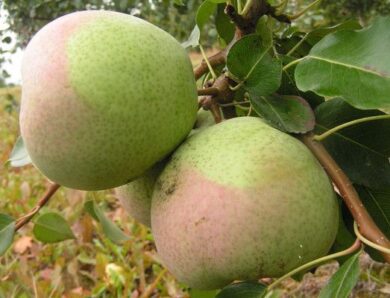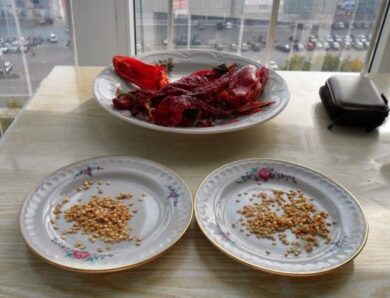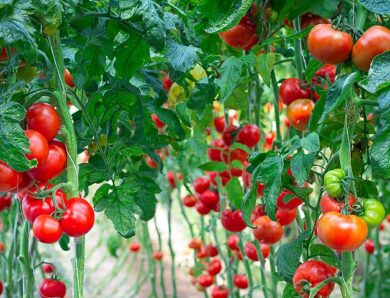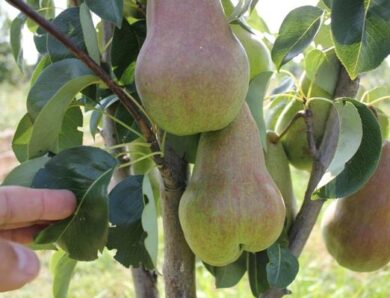Apple Champion: description and main characteristics of the variety
Apple Champion is well known for its fragrant sweet fruit with a bright blush. It is widely cultivated in the mild climate of Europe, in Ukraine, southern regions of Belarus and Russia, in the Middle Belt is also grown, but very often you have to cover the trees for the winter.
variety description
The Jaint Champion variety was created in Czechoslovakia, with 1970 year, he firmly took his place in the market. Compact trees with oval crowns begin to bear fruit in the second year, if grafted on dwarf and semi-dwarf rootstocks, grow up 2,5-3 meters. On medium-sized rootstocks, they grow to 4-5 meters, come into fruition through 3-4 years after planting.
Thin brown branches grow at an acute angle to the trunk, large growth of small twigs do not differ, to stimulate their growth, it is recommended to carry out annually shortening pruning. The leaves are light green, elongated, with finely serrated edge, and the flowers are white, sometimes with a pink tinge. In the spring, during flowering, the tree looks very impressive due to the large number of delicate flowers, but not all of them form ovaries - apple variety Champion is partially self-fertile, for a good harvest, other varieties must grow nearby. Idared are considered to be excellent pollinators, Alba, Lobo, Pilot, Florina, in the presence of one of them from one adult tree the Champion can be removed 25 kg of fruit.
Main characteristics
The description of the variety emphasizes the quality of the fruit, for which apple trees are grown not only in private yards, but also on farms for commercial purposes. Large round apples are one-dimensional with medium weight 200 G, main color - greenish-yellow, much is covered with a bright orange-red blush with well-visible subcutaneous spots. Apples have a very pleasant sour-sweet taste, due to the high content of sugars and ascorbic acid. The flesh of light, fine-grained, if you remove the apples from the branches late, then it softens noticeably. The skin is thin, but strong and elastic, the fruit must be well packed during transportation, so that they do not fight against each other.
Harvested in mid-September, when the main color of apples from green begins to turn yellow, across 1-2 weeks the fruits reach consumer maturity. Overripe fruits do not fall off the trees, but the quality of their taste decreases. The characteristic of apples notes their versatility - good fresh, suitable for desserts and winter preparations. Store in the refrigerator until 5 months, in the cellars - to 2 months. Industrial storages with constant temperature +1 ??or +1,5 degrees, humidity 85% and gas control preserve the crop until mid-spring. Arno and Reno clones have been created. So the apple of the Champion Renault variety differs in sweeter apples, almost completely covered with red blush.
Growing and care
Apple trees can be planted in early spring (then they will have time to strengthen before winter) or in the fall (to take root before winter, and in the spring will start to grow faster), and if the seedlings are purchased with closed roots, then they are planted throughout the season. It is better to find a sunny place, but protected from the north wind, laying the garden, trees are planted from north to south in the distance 2 meters between them and 4 meters between rows. The landing pit is prepared for 1-2 weeks, the soil is mixed with mineral fertilizers, humus, compost and wood ash. Plant like this, so that the root collar remains at a height of up to 9 see above ground level, tied to a peg, abundantly watered, mulch.
Tree growth slows down with the onset of fruiting, by this time it is necessary to form a crown, branches are shortened annually slightly to stimulate branching. Trees need constant watering, especially in dry hot weather. Fertilizers should be applied to the ground under the crown, not limited to the stump circle, to do this, organize small grooves (if top dressing is combined with watering) or pits in the projection of the crown, dry fertilizers can simply be scattered or spread before watering. Trees respond well to foliar feeding. Nitrogen is applied only by mid-June, later it is desirable to focus on phosphorus.
Diseases and pests
Reviews of gardeners say so, that the Champion very rarely suffers from pests, but diseases can harm apple trees. This variety has a medium resistance to scabies. If you do not provoke it by watering with cold water, and the tree will have enough sun, then the fruits and leaves will not face this calamity. Resistance to powdery mildew is weaker. In early spring and autumn, the apple tree is recommended to spray Bordeaux liquid or a solution of copper sulfate for disease prevention.
But the biggest trouble can cause bacterial burns and bitter dimples. The sooner the owner notices the signs of bacterial burns, the easier it will be to fight it, using special drugs. To avoid bitter pitting, from June until the autumn harvest is held at least 10 spraying on the leaves with calcium fertilizers.
Pros and cons
The undoubted advantages of the Champion include its early fruiting, regularity of harvest, after all almost every year without any periodicity the adult tree gives not less 25 kg of excellent fruit in the presence of pollinators. High taste and marketable qualities of apples of universal use along with good yield allow to grow trees for commercial purposes.
Average winter hardiness, which allows you to grow the variety only in regions with mild winters, insufficient resistance to powdery mildew, bacterial burns and bitter dimples, which brings considerable trouble to the gardener, - The main disadvantages of the Champion. Undoubtedly, it is worth growing this variety, since the pros, obviously, outweigh all the disadvantages.
Video "Review of autumn and winter varieties of apples
In this video you can get acquainted with autumn and winter varieties of apples, growing in the Urals.




